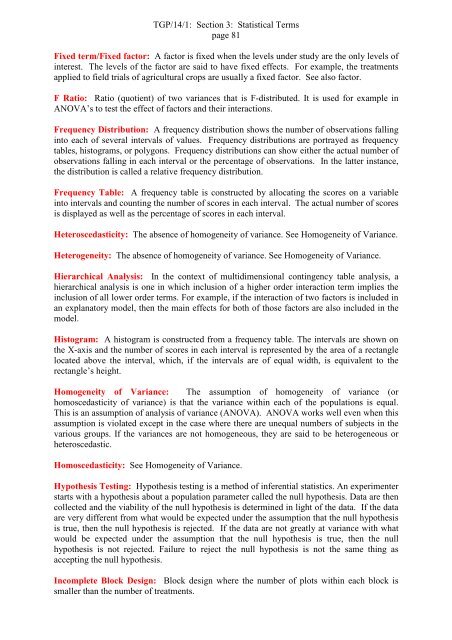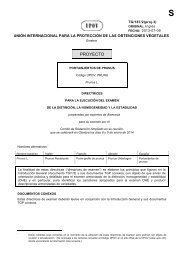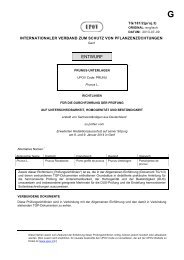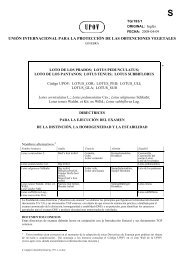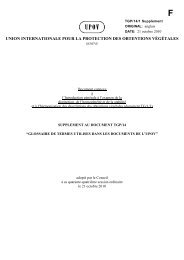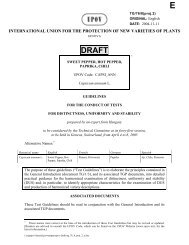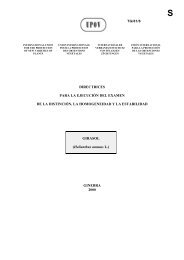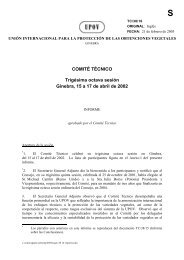E - International Union for the Protection of New Varieties of Plants
E - International Union for the Protection of New Varieties of Plants
E - International Union for the Protection of New Varieties of Plants
Create successful ePaper yourself
Turn your PDF publications into a flip-book with our unique Google optimized e-Paper software.
TGP/14/1: Section 3: Statistical Terms<br />
page 81<br />
Fixed term/Fixed factor: A factor is fixed when <strong>the</strong> levels under study are <strong>the</strong> only levels <strong>of</strong><br />
interest. The levels <strong>of</strong> <strong>the</strong> factor are said to have fixed effects. For example, <strong>the</strong> treatments<br />
applied to field trials <strong>of</strong> agricultural crops are usually a fixed factor. See also factor.<br />
F Ratio: Ratio (quotient) <strong>of</strong> two variances that is F-distributed. It is used <strong>for</strong> example in<br />
ANOVA’s to test <strong>the</strong> effect <strong>of</strong> factors and <strong>the</strong>ir interactions.<br />
Frequency Distribution: A frequency distribution shows <strong>the</strong> number <strong>of</strong> observations falling<br />
into each <strong>of</strong> several intervals <strong>of</strong> values. Frequency distributions are portrayed as frequency<br />
tables, histograms, or polygons. Frequency distributions can show ei<strong>the</strong>r <strong>the</strong> actual number <strong>of</strong><br />
observations falling in each interval or <strong>the</strong> percentage <strong>of</strong> observations. In <strong>the</strong> latter instance,<br />
<strong>the</strong> distribution is called a relative frequency distribution.<br />
Frequency Table: A frequency table is constructed by allocating <strong>the</strong> scores on a variable<br />
into intervals and counting <strong>the</strong> number <strong>of</strong> scores in each interval. The actual number <strong>of</strong> scores<br />
is displayed as well as <strong>the</strong> percentage <strong>of</strong> scores in each interval.<br />
Heteroscedasticity: The absence <strong>of</strong> homogeneity <strong>of</strong> variance. See Homogeneity <strong>of</strong> Variance.<br />
Heterogeneity: The absence <strong>of</strong> homogeneity <strong>of</strong> variance. See Homogeneity <strong>of</strong> Variance.<br />
Hierarchical Analysis: In <strong>the</strong> context <strong>of</strong> multidimensional contingency table analysis, a<br />
hierarchical analysis is one in which inclusion <strong>of</strong> a higher order interaction term implies <strong>the</strong><br />
inclusion <strong>of</strong> all lower order terms. For example, if <strong>the</strong> interaction <strong>of</strong> two factors is included in<br />
an explanatory model, <strong>the</strong>n <strong>the</strong> main effects <strong>for</strong> both <strong>of</strong> those factors are also included in <strong>the</strong><br />
model.<br />
Histogram: A histogram is constructed from a frequency table. The intervals are shown on<br />
<strong>the</strong> X-axis and <strong>the</strong> number <strong>of</strong> scores in each interval is represented by <strong>the</strong> area <strong>of</strong> a rectangle<br />
located above <strong>the</strong> interval, which, if <strong>the</strong> intervals are <strong>of</strong> equal width, is equivalent to <strong>the</strong><br />
rectangle’s height.<br />
Homogeneity <strong>of</strong> Variance: The assumption <strong>of</strong> homogeneity <strong>of</strong> variance (or<br />
homoscedasticity <strong>of</strong> variance) is that <strong>the</strong> variance within each <strong>of</strong> <strong>the</strong> populations is equal.<br />
This is an assumption <strong>of</strong> analysis <strong>of</strong> variance (ANOVA). ANOVA works well even when this<br />
assumption is violated except in <strong>the</strong> case where <strong>the</strong>re are unequal numbers <strong>of</strong> subjects in <strong>the</strong><br />
various groups. If <strong>the</strong> variances are not homogeneous, <strong>the</strong>y are said to be heterogeneous or<br />
heteroscedastic.<br />
Homoscedasticity: See Homogeneity <strong>of</strong> Variance.<br />
Hypo<strong>the</strong>sis Testing: Hypo<strong>the</strong>sis testing is a method <strong>of</strong> inferential statistics. An experimenter<br />
starts with a hypo<strong>the</strong>sis about a population parameter called <strong>the</strong> null hypo<strong>the</strong>sis. Data are <strong>the</strong>n<br />
collected and <strong>the</strong> viability <strong>of</strong> <strong>the</strong> null hypo<strong>the</strong>sis is determined in light <strong>of</strong> <strong>the</strong> data. If <strong>the</strong> data<br />
are very different from what would be expected under <strong>the</strong> assumption that <strong>the</strong> null hypo<strong>the</strong>sis<br />
is true, <strong>the</strong>n <strong>the</strong> null hypo<strong>the</strong>sis is rejected. If <strong>the</strong> data are not greatly at variance with what<br />
would be expected under <strong>the</strong> assumption that <strong>the</strong> null hypo<strong>the</strong>sis is true, <strong>the</strong>n <strong>the</strong> null<br />
hypo<strong>the</strong>sis is not rejected. Failure to reject <strong>the</strong> null hypo<strong>the</strong>sis is not <strong>the</strong> same thing as<br />
accepting <strong>the</strong> null hypo<strong>the</strong>sis.<br />
Incomplete Block Design: Block design where <strong>the</strong> number <strong>of</strong> plots within each block is<br />
smaller than <strong>the</strong> number <strong>of</strong> treatments.


